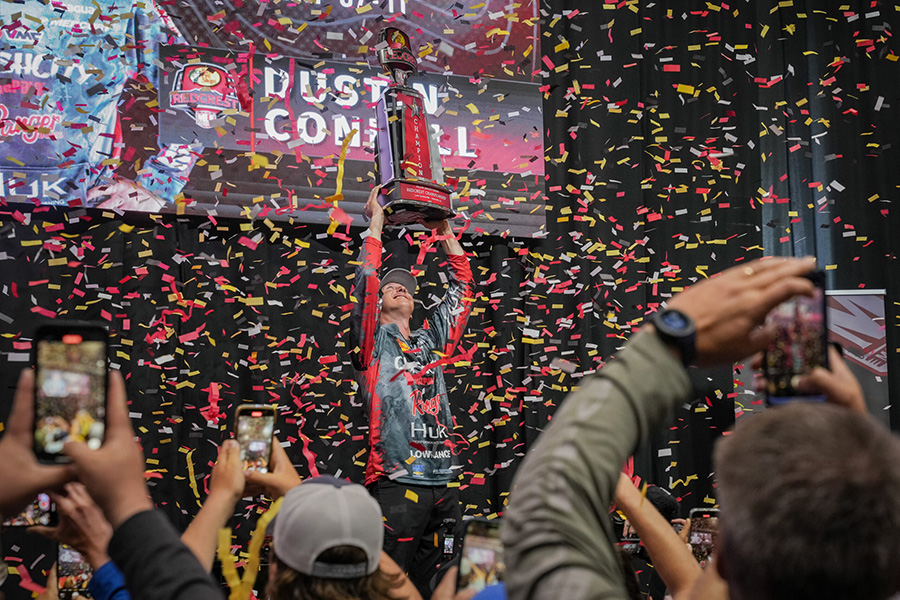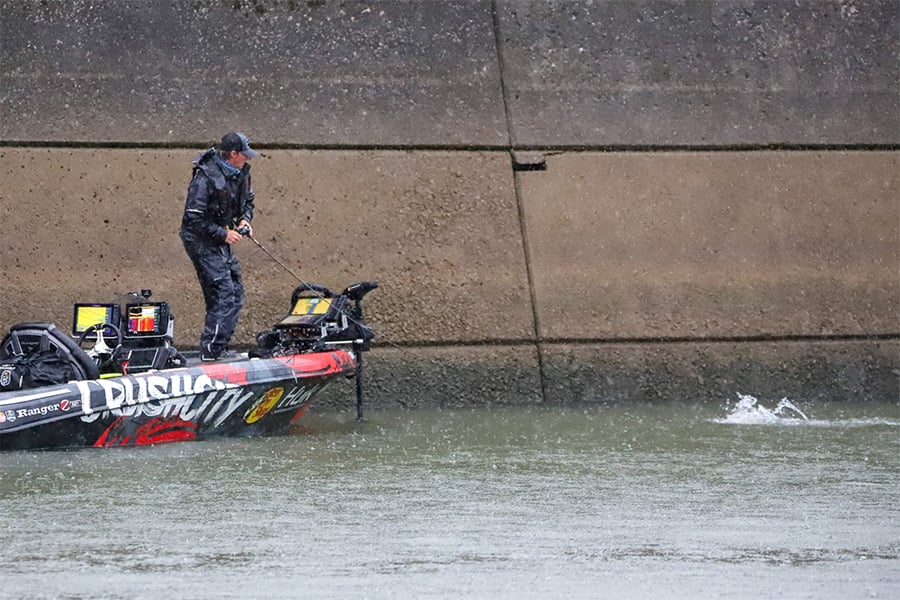
Dustin Connell lifts the REDCREST trophy for a third time
Expertise reading current, map contours and 2D sonar helped Lowrance Pro Dustin Connell win his third Major League Fishing REDCREST championship tournament. In each win in his historic trio – the latest on Lake Guntersville, last week – C-MAP charts and Lowrance electronics helped him find and catch the winning bass on a reservoir in his home state of Alabama.
“Shout-out to Lowrance for having all the good C-MAP [charts] and allowing me to find these areas that I did,” Connell said in video posted to Lowrance’s Facebook page Sunday, shortly after he’d hoisted aloft a REDCREST trophy for a third time in his stellar career. “I literally could idle and see where the bait’s at, really quick, [to] know where to fish.”
Connell won this year’s REDCREST with two main patterns – targeting spawning smallmouth on subtle, up-river hard-bottom flats extending out from the shoreline; and “tight-lining” pre-spawn smallmouth and spotted bass suspending in deep water directly below the dam that separates Guntersville from Lake Nickajack on the famed Tennessee River.
“I am running way up the river and we are catching spawning smallmouth, using my C-MAP [charts],” Connell said of his first pattern, which eventually gave way to his dam pattern. “I’m going through my chart and I’m seeing any of these places that kind of run out in the river – just a small subtle flat that’s got gravel and rock on them.”
Seated at the console of his boat prior to blast-off in heavy rain on Championship Sunday, Connell identified an example of what he’d been describing, pointing to the brightly colored C-MAP chart of Guntersville displayed on one of two Lowrance HDS® PRO units mounted above his steering wheel. “They’re spawning on places like that, like that little place,” he said, zooming in and pointing a finger at the subtle structure showing on his map. “Pull up, throw a jerkbait. … I’m just looking for those little subtle differences in that river system.”
When fishing just below the dam – the pattern Connell committed to fully in the tournament’s third competition day, the Knockout Round – both his C-MAP chart and 2D sonar were up and running on his Lowrance screens at bow and console. His map showed the tailrace’s current-affecting structures and deepest areas. His 2D sonar showed the depths at which baitfish and bass were suspending in those areas.
"I am running 2D on my boat as well … to always notice where the bait was at,” Connell told BassBlaster scribe Jay Kumar. “I would let [my bait] sink down that wall … working it deeper and getting more bites. Seeing the bait get lower in the water column [on 2D] helped.”
Four to five tail-race areas produced the most bass for Connell, he said in his champion’s press conference Sunday night. They included the main lock wall, the dam’s three wing walls and “some industrial stuff” a little further downriver from the dam. He targeted deeper water in those areas, which was easy to see on his C-MAP chart, which glowed brightly with vivid custom-shaded colors the entire time he expertly caught bass after bass in the Knockout and Championship rounds.
“That dam is so deep, that’s what made those wing walls very good,” Connell said in his press conference. “That deep water harbors that bait around those walls, so [the bass] just suspend. They’re not necessarily deep, they’re just on the walls, suspending. I knew where they were going to be at.”
Spot-on-the-spot features in the dam area’s deeper water, not evident to the naked eye, included “little jut-outs where the current hit hard along the wall, the tip of the wall, the back corner of the wall, the front corner of the wall,” Connell told BassBlaster’s Kumar.

Fishing beside Lake Guntersville dam
Patience running his pattern was essential, Connell said. After catching a few bass on his best spots, he’d rotate to another one of his best spots, letting the bass re-load where he’d just left. “I’d let ‘em chill for a little bit and then come back,” he explained in his press conference. “Just had a little ‘milk run.’”
Although Connell is among the best forward-facing-sonar specialists in all of professional fishing, he used his Lowrance Active Target® 2 only occasionally in this year’s REDCREST. The churning water and bait below the dam made for too cluttered a screen, he explained in MLF’s Championship Round Post Game Show. “This afternoon, I cut it on just in case I wanted to go hit some flats,” he elaborated. “But I couldn’t see up there – there was so much current [and] and so much shad. So I said, ‘Nah, I ain’t even gonna bother with it.’ But I definitely would have used it if I could. I absolutely love doing that technique.”
In REDCREST and Major League Fishing Bass Pro Tour tournaments, anglers can utilize forward-facing sonar in only one of three competition periods per day. “I feel as if I’m very good with that technology,” Connell said in the Post Game Show. “I use Active Target 2. And it’s phenomenal, and I’ve caught so many bass using it. … I feel like if I utilize that to my best abilities, I’d have an advantage. But this time of year, they’re spawning – you can’t do it. So I didn’t cut it on.”
Ultimately, Connell’s expertise at reading maps, 2D sonar and current earned him the win on Gunterville.
“When you current-fish, you can go anywhere in the country, and when you understand it, I feel like you can apply it to any kind of current fishing,” he explained in his press conference. “And that’s how I love fishing – I grew up that way; I was 12 years old fishing below a dam, understanding current seams, rockpiles. I literally can look at a dam and tell you where they’re going to be at.”
“Doing this tournament my way was such an accomplishment,” Connell said further. “I’m so proud that I stuck to my roots. It’s just super special.”
In four days of competition, Connell caught 88 bass weighing a combined 255 pounds, 2 ounces. In the Championship Round, he caught 29 bass weighing a combined 87 lbs., 11 oz. He won $300,000 in prize money.








